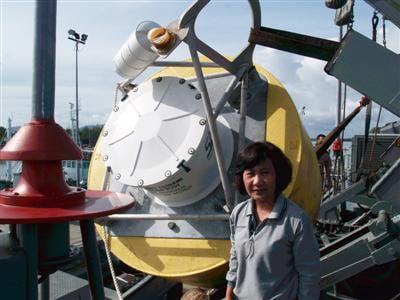New tsunami buoys off Phuket by new year: NDWC

PHUKET: Two new Italian-built tsunami direct detection units will be installed off Phuket by the end of the year, the National Disaster Warning Center (NDWC) has revealed.
NDWC Director Somsak Khaosuwan said the two units, known as “tsunameters”, will be located about 400 to 500 kilometers offshore.
Although the exact locations have yet to be determined, one of the units will likely be deployed west of Phuket while the other will be further north near the Surin Islands, he said.
“We will deploy them as soon as possible to ensure the safety of residents and tourists along Thailand’s Andaman coastline,” said Dr Somsak, who has been promoted to director of the NDWC after serving as its director of operations for more than a year.
The launch mission is scheduled to depart from the Phuket Marine Biological Center pier on December 11.
The two new “Poseidon Class” tsunameters, built by the Italian firm Envirtech, will be deployed under a total budget of about 135 million baht, he said.
Envirtech in June 2006 installed two tsunameters in the Bay of Bengal under a contract with the Indian Government.
Like the Indian tsunameters, real-time data from the units will not be available to the public through the US Government’s National Data Buoy Center website, however.
“The public will be able to monitor data in real time, but through a different website. We will announce the website URL to the public after the unit is in place and operational,” Dr Khaosuwan said.
Thailand is currently without tsunami direct detection capability.
Its first tsunameter, supplied by the US government through its National Oceanic and Atmospheric Administration (NOAA), was deployed about 1,100 kilometers northwest of Phuket in December 2006.
It was the only operational unit in the Indian Ocean linked to the US Pacific Tsunami Warning Center (PTWC) network.
After its deployment in 2006, maintenance of the Deep-ocean Assessment and Reporting of Tsunamis unit, or “DART-II”, fell to the Thai Meteorological Department (TMD). The buoy was designed to have maintenance and a change of battery every year, but political and bureaucratic issues in Thailand prevented this from ever happening.
The battery finally ran out in June 2009.
The entire unit was replaced six months later by a new tsunameter supplied under an NDWC contract with Bangkok-based firm Raydant International, which also built and operates the network of over 100 tsunami warning towers in the Andaman Coast region.
But the Raydant DART-II unit went adrift in June this year and has yet to be replaced. Vandalism from a fishing vessel was given as the most likely cause, according to Raydant management.
Raydant General Manager Aurasa Paenghom said the NOAA DART-II buoy is currently undergoing maintenance in the USA, while the Raydant unit is in storage at the naval base in Phang Nga.
The Raydant unit will be redeployed in its former location as soon as possible after a new mooring line on order from abroad is delivered, she said.
“The first buoy was sent to the US four months ago and should have been returned by now. As for the second unit that was damaged, we expect the replacement mooring line to arrive in December ahead of redeployment in January,” she said.
Raydant plans to swap out the two units year after year so that maintenance can be done on shore.
NDWC Director Dr Somsak said the public should not be unduly worried about the current lack of tsunami direct detection capability.
The NDWC still has access to water level data from the Royal Thai Navy’s water level monitor at its station on Koh Miang in the Similan Island chain, the PTWC network and other sources, he said.
“People should not worry about not having enough time to evacuate,” he said.
Dr Somsak sees eventually having three tsunameters operating under two different monitoring networks as an operational advantage.
“In case one system goes down, we will still have another to go through,” he said.
In a related development, Dr Somsak reiterated that NDWC never triggered a “false alarm” tsunami alert on the November 6, as has been reported in areas including Mai Khao and Kamala in Phuket and other sites in the Andaman coast region.
“I checked the situation as soon as I heard these reports. At first some said the sirens sounded at Ao Nang [in Krabi], some said in Nai Yang and Kamala, or even in Thai Muang [Phang Nga], but we couldn’t confirm soundings in any of these areas,” he said.
However, Phuket Governor Tri Augkaradacha, the president of Mai Khao Tambon Administration Organization (TAO) and the vice-president of Kamala TAO all confirmed to the Gazette that tsunami warning towers sounded on the date in question.
Tampering by local people might have been responsible if noises were heard from the speakers, Dr Somsak said.
Such tampering is known to have occurred in Phang Nga, where villagers hacked into the system to use the speakers for other purposes, he said.
Strong winds can also produce sounds that could be mistaken for a tsunami warning tower alarm, he said.
— P. Choksakulpan & S. Fein
Latest Thailand News
Follow The Thaiger on Google News:


























